
Introduction
Definition of Machine Learning Algorithms
Machine learning algorithms are essentially the brainy workhorses that allow computers to learn from data without explicit programming. Imagine teaching a toddler to recognize animals through pictures instead of just telling them what each animal is. That’s machine learning in a nutshell! These algorithms analyze data, identify patterns, and make decisions based on what they’ve learned.
Some common types include:
- Supervised Learning: Learning with labeled data, like training a dog with treats for good behavior.
- Unsupervised Learning: Finding patterns in unlabeled data, akin to sorting your sock drawer without knowing which sock belongs to which pair.
- Reinforcement Learning: Learning through trial and error, quite like figuring out how to ride a bike.
Significance of Studying Different Types
Now, why should anyone bother diving into the sea of types of machine learning algorithms? Understanding these algorithms is crucial because each type serves a specific purpose and excels in different scenarios. For instance, supervised learning is fantastic for predictive tasks, while unsupervised learning shines in exploratory data analysis.
By familiarizing ourselves with these distinctions:
- We can make informed choices in our projects.
- Tailor our approach to problem-solving.
- Ultimately harness the full potential of data in real-world applications.
So yes, understanding these algorithms might just save you from pulling your hair out—or worse, making the wrong choice for your data problem. The world of algorithms awaits, and we’ve only scratched the surface!
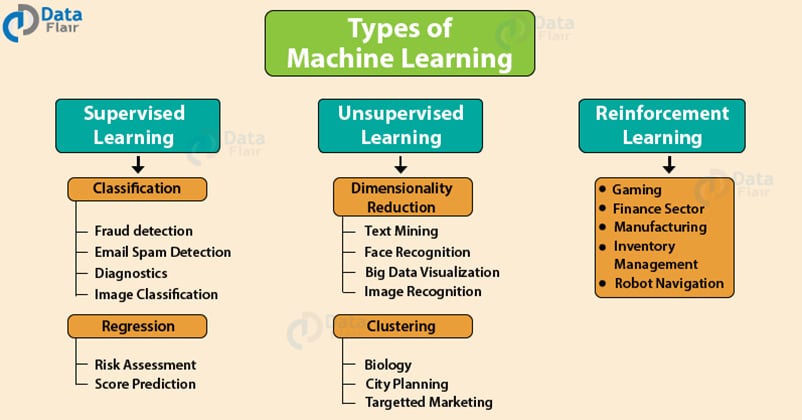
Supervised Learning Algorithms
Linear Regression
Let’s kick things off with Linear Regression. Picture yourself trying to predict the price of a house based on its size. Linear regression does just that by fitting a straight line through a set of data points. It’s like connecting the dots to see the bigger picture—very satisfying! It assumes there’s a linear relationship between the input variables and the output variable, perfect for forecasting.
Key Features:
- Predicts continuous outcomes.
- Simple to understand and implement.
- Sensitive to outliers which can skew results.
Support Vector Machines (SVM)
Next up is Support Vector Machines (SVM). Think of SVM as your trusty bodyguard at a party—separating the “good” folks from the “not-so-good” ones. SVM creates a hyperplane that best separates different classes in your data. It’s particularly handy when there’s a clear gap between categories.
Key Benefits:
- Effective in high-dimensional spaces.
- Works well with both linear and non-linear data.
- Robust against overfitting when using the right kernel trick.
Decision Trees
Finally, let’s talk about Decision Trees. Ever been on one of those “choose your adventure” paths? Well, decision trees are just like that! They split data into branches based on feature values until reaching a final decision or outcome at the leaf nodes. They’re visually intuitive and easy to understand—perfect for explaining complex decisions without sounding like a rocket scientist.
Advantages of Decision Trees:
- Handles both numerical and categorical data.
- Requires little data preprocessing.
- Easy to interpret through visual representation.
These supervised learning algorithms are the bread and butter of machine learning, each with its own unique flavor to serve up in different scenarios! So the next time you’re stuck in a data conundrum, remember that there’s an algorithm just waiting to lend a hand.
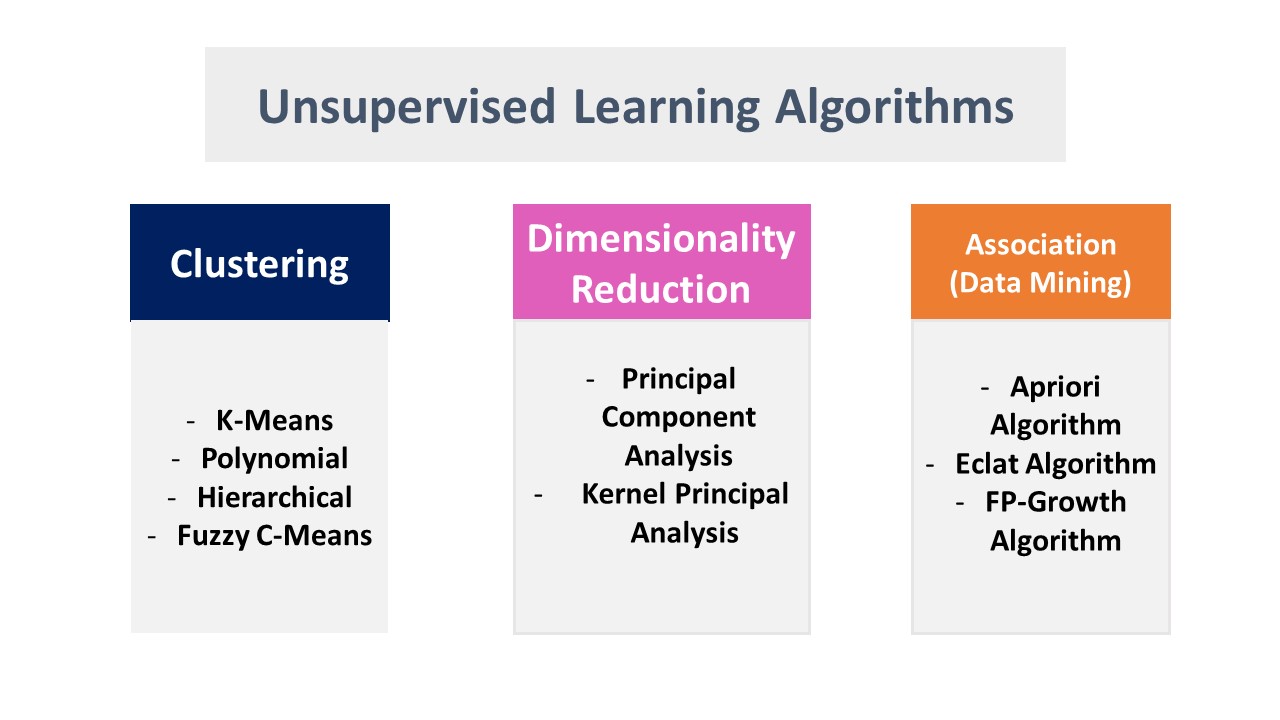
Unsupervised Learning Algorithms
K-Means Clustering
Now, let’s move on to the intriguing realm of unsupervised learning algorithms, starting with K-Means Clustering. Imagine a party where guests naturally group into circles of friends without any invitations or guidance! K-Means uses this concept by dividing a set of data points into K distinct clusters based on their features. It’s simple yet powerful for segmenting customers or identifying patterns in data.
How It Works:
- Choose the number of clusters (K).
- Randomly assign initial centroids.
- Assign data points to the nearest centroid and update centroids iteratively until stability.
Hierarchical Clustering
Next, we have Hierarchical Clustering. If K-Means is the party-goer who sticks to a predetermined number of groups, then hierarchical clustering is the charming host who embraces a more organic gathering. This algorithm builds a tree of clusters, allowing you to see data grouped at multiple levels. The result? A detailed, visual representation akin to a family tree!
Types to Consider:
- Agglomerative: Start with individual points and merge into larger clusters.
- Divisive: Begin with a single cluster and split into smaller ones.
Principal Component Analysis (PCA)
Finally, let’s touch on Principal Component Analysis (PCA). Think of PCA as giving your data a much-needed facelift. It transforms the data into a new coordinate system, reducing dimensions while retaining the most important features. This way, we can visualize complex data and maintain interpretability, just like decluttering a messy room to make it more functional!
Why Use PCA?
- Simplifies data without losing significant information.
- Reduces computational cost in later analyses.
- Enhances visualizations for easier interpretation.
With these unsupervised learning algorithms, you have the tools to unveil hidden patterns and relationships in your data, paving the way for exciting discoveries! Whether you’re clustering customers or simplifying the intricacies of your data, these algorithms let you explore without the need for labels. Let’s dive deeper!

Semi-Supervised and Reinforcement Learning Algorithms
Introduction to Semi-Supervised Learning
Now that we’ve danced through the world of unsupervised learning, let’s explore the exciting territory of semi-supervised learning. This approach is like bridging two worlds—imagine you have a ton of unlabeled data (like your messy sock drawer) and just a few labeled examples (your favorite paring of socks). Semi-supervised learning intelligently uses both types to build more accurate models. It’s particularly effective when labeling data is expensive or time-consuming.
Key Characteristics:
- Combines the strengths of both supervised and unsupervised learning.
- Maximizes the utility of a small labeled dataset amidst a larger unlabeled set.
- Often leads to improved performance, especially in image and text classification tasks.
Understanding Reinforcement Learning
Transitioning from semi-supervised, let’s dig into the world of Reinforcement Learning (RL). Think of RL as training a dog—there’s plenty of trial and error involved! An agent (like your pup) interacts with the environment, receiving rewards (treats) for good behavior and penalties (no treats) for bad decisions. Over time, the agent learns to make better choices, optimizing its strategy to maximize rewards.
Core Elements of RL:
- Agent: The learner or decision maker.
- Environment: The space where the agent operates.
- Actions: Choices the agent makes that affect the environment.
- Rewards: Feedback given to the agent for its actions.
Reinforcement learning is crucial for developing complex systems, from game-playing AIs to autonomous vehicles. With these innovative approaches, we’re beginning to see machines learning in ways that resemble human-like strategies. Exciting, isn’t it?
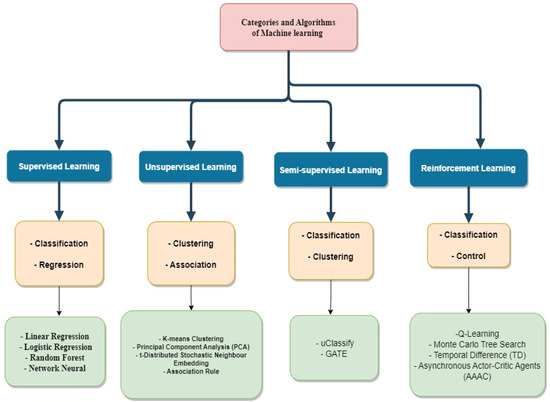
Neural Network Algorithms
Feedforward Neural Networks
Shifting gears into the domain of Neural Network Algorithms, let’s first unwrap Feedforward Neural Networks. Think of them as the straightforward learners of the bunch—they simply receive inputs, process them through layers of neurons, and provide outputs. It’s like a brilliant chef who carefully follows a recipe to whip up a delicious dish without altering the steps.
Key Features:
- Composed of an input layer, hidden layers, and an output layer.
- Information moves in one direction—from input to output.
- Great for functions and simple prediction tasks.
Convolutional Neural Networks (CNN)
Now, let’s move on to Convolutional Neural Networks (CNN). These are the absolute rockstars in image recognition tasks, treating images like intricate puzzles. Instead of analyzing pixels individually, CNNs look for patterns and features, making them perfect for tasks like facial recognition. It’s like having an advanced magnifying glass that zooms in on important features.
Advantages of CNNs:
- Efficiently processes visual data.
- Reduces the number of parameters through local connectivity.
- Robust against small shifts and distortions.
Recurrent Neural Networks (RNN)
Next up is Recurrent Neural Networks (RNN). Unlike their feedforward cousins, RNNs have memory—they remember previous inputs and use them in future computations. Think of a writer who recalls earlier chapters before crafting the next one; it’s particularly useful in time-series predictions or natural language processing (NLP).
Features of RNNs:
- Processes sequence data—text, speech, or any data with a time component.
- Can handle variable-length inputs, adding flexibility.
- Usually accompanied by techniques like Long Short-Term Memory (LSTM) to combat issues like vanishing gradients.
Deep Learning Algorithms
Finally, let’s talk about Deep Learning Algorithms. These algorithms take neural networks up a notch, packing many hidden layers into one model. It’s like diving deeper into a rabbit hole—impressive complexity leads to incredible performance in tasks such as speech recognition and game-playing AIs.
Benefits of Deep Learning:
- Allows for the extraction of abstract features from raw data.
- Capable of handling vast amounts of data.
- Continuously improves as more data becomes available.
In summary, neural networks, with their various forms, are at the heart of many modern AI advancements. Their ability to learn from vast datasets makes them a cornerstone of success in today’s machine learning ecosystem!
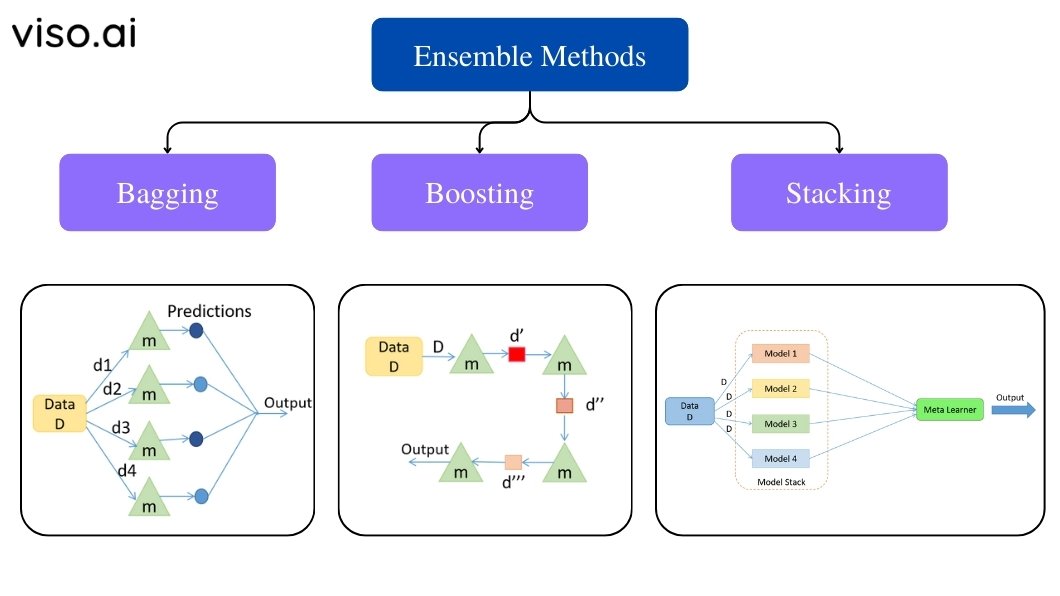
Ensemble Learning Algorithms
Bagging (Bootstrap Aggregating)
As we pivot towards Ensemble Learning Algorithms, let’s kick things off with Bagging (Bootstrap Aggregating). Imagine you’re planning a big get-together and ask several friends for their opinions on the best pizza toppings. Each friend might have a different favorite, but by averaging their suggestions, you can end up with a pizza that pleases most! That’s the essence of Bagging—it combines multiple models to enhance stability and accuracy.
How Bagging Works:
- Multiple subsets of data are created through random sampling (with replacement).
- Each subset trains its own base model (like decision trees).
- Final predictions are made by aggregating results (e.g., majority voting for classification).
This method is fantastic for reducing variance and combating overfitting, especially for models that are sensitive to fluctuations in data.
Boosting (Adaptive Boosting and Gradient Boosting)
Next is Boosting, which is like an avid student who learns from each quiz to improve performance on the next one. Boosting algorithms, such as Adaptive Boosting (AdaBoost) and Gradient Boosting, focus on the mistakes made by previous models and aim to correct them.
Core Principles of Boosting:
- Models are trained sequentially, with each new model focusing on the errors made by its predecessor.
- Weighs each training instance based on its difficulty level, pushing harder on misclassified points.
- The final model is a weighted combination of all weak learners, which together work to improve prediction.
Boosting pushes the envelope on prediction accuracy, making it incredibly popular for complex tasks, from credit scoring to complex recommendation systems. The synergy of ensemble algorithms illustrates the power of collaboration in machine learning, achieving better results than any single model could manage alone. With such diverse strategies at our disposal, tackling real-world problems becomes a dynamic adventure!

Evolutionary Machine Learning Algorithms
Genetic Algorithms
Now, let’s dive into the fascinating world of Evolutionary Machine Learning Algorithms, starting with Genetic Algorithms. If you’ve ever marveled at how species evolve over time, you’re already halfway to understanding this concept! Genetic algorithms mimic the process of natural selection to solve optimization problems. It’s like sending a group of contestants to a competitive reality show, where only the most fit survive to create the next generation.
How Genetic Algorithms Work:
- Initialization: A random population of candidate solutions is created.
- Selection: The best-performing candidates are chosen based on a fitness criteria.
- Crossover and Mutation: Selected candidates are combined and slightly altered to form a new generation.
This iterative process continues, allowing the algorithm to evolve better solutions over successive generations, making them perfect for complex problems like scheduling and routing.
Genetic Programming
Onward to Genetic Programming, a fun twist that takes Genetic Algorithms to the next level! Instead of optimizing numerical values, genetic programming evolves entire programs or functions. It’s like redefining the rules of the game. Imagine being able to create algorithms that can generate other algorithms; that’s the magic of genetic programming!
Key Features:
- Structures are usually tree-like and represent potential solutions.
- It searches through the space of possible programs, tweaking them until it creates a program that performs well.
- Great for tasks involving symbolic regression, automatic code generation, and even game playing.
By leveraging the principles of evolution, both Genetic Algorithms and Genetic Programming provide innovative ways to explore complex solutions, showcasing that sometimes, nature really knows best. As machine learning continues to evolve, it’s exciting to think about how these biological inspirations will shape future technologies!
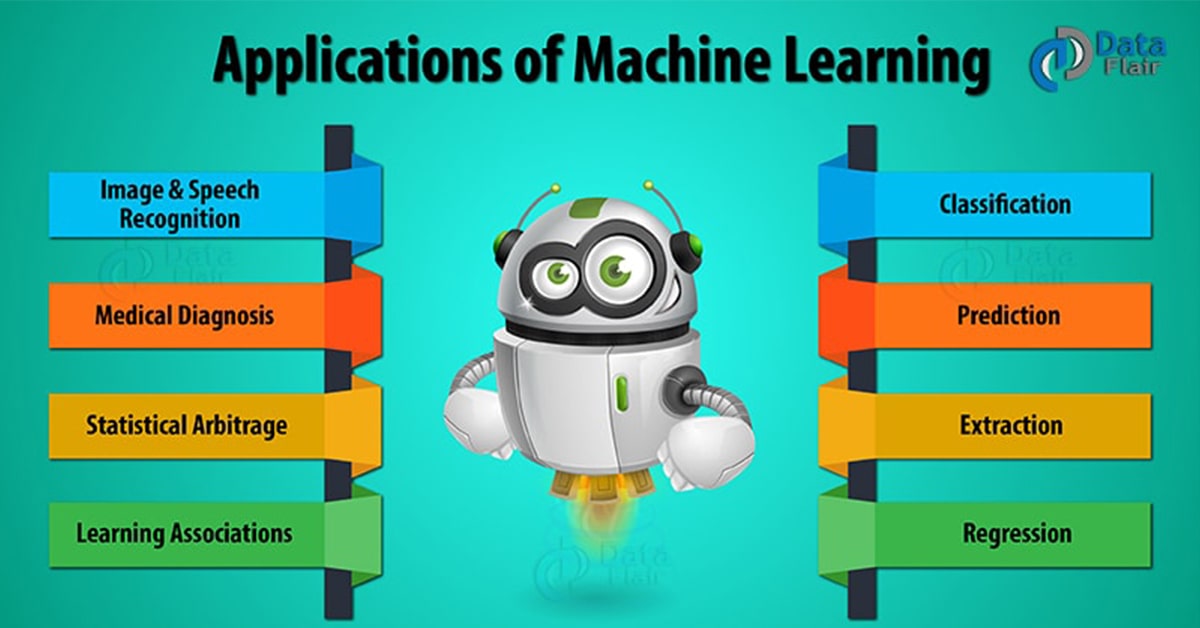
Case Studies and Real-World Applications
Machine Learning Algorithms in Healthcare
Transitioning from the theory and mechanics of machine learning, let’s explore a couple of fascinating real-world applications. Starting with healthcare, machine learning algorithms are revolutionizing patient care and medical research. Imagine a world where diseases are diagnosed with the accuracy of a top-notch detective. That’s what algorithms are doing!
Examples of Applications:
- Predictive Analytics: Algorithms can analyze patient data to predict outcomes like readmission rates or disease progression.
- Medical Imaging: CNNs (Convolutional Neural Networks) are used to detect anomalies in MRI scans, often outperforming human radiologists.
A personal experience: I once attended a conference where a startup showcased a predictive model that helped detect lung cancer at its earliest stage. It was a game changer, potentially saving countless lives!
Machine Learning Algorithms in Finance
Now, let’s shift gears to finance—the playground of machine learning algorithms, where numbers dance and fortunes are made (or lost). From fraud detection to algorithmic trading, the financial sector is embracing machine learning to enhance decision-making processes.
Key Use Cases:
- Fraud Detection: Algorithms can analyze spending patterns in real-time, flagging unusual transactions that could indicate fraud.
- Algorithmic Trading: Financial institutions leverage predictive models to execute trades based on market trends and events with extraordinary speed.
In fact, I once heard a story from an investor who attributed part of his success to a machine learning model he implemented that analyzed vast datasets to uncover undervalued stocks. Talk about a cutting-edge advantage!
Both healthcare and finance are prime examples of how machine learning algorithms are transforming entire industries, providing smarter insights and enhancing our ability to make informed decisions. The future is indeed bright with these technologies in play!
.jpg)
Choosing the Right Algorithm
Factors to Consider
Now that we’ve explored the practical applications of these algorithms, let’s delve into the nitty-gritty of choosing the right one for your needs. The process might feel overwhelming, like trying to select the best avocado at the grocery store, but fear not! There are key factors to guide you:
Key Considerations:
- Nature of the Problem: Is it a classification task, regression, or perhaps clustering? Understanding the problem is crucial.
- Data Quality and Quantity: Do you have enough labeled data? If not, semi-supervised or unsupervised algorithms may be a better fit.
- Interpretability: Sometimes, you may need a model that’s easy to explain to stakeholders—think of decision trees for clarity.
Decision-making Process
The decision-making process itself can be likened to assembling a puzzle. You’ll want to start with the corner pieces—understanding your objectives and constraints. My experience in choosing algorithms for a project taught me the importance of prototyping several models.
Here’s a simple roadmap:
- Define the problem and gather the relevant data.
- Explore different algorithms based on your considerations.
- Implement a few selected algorithms and evaluate their performance.
- Select the model that best meets your needs and deploy it.
Remember, there’s rarely a one-size-fits-all algorithm. It’s often about trial and error, so don’t hesitate to iterate on your choices. With careful consideration and a structured approach, finding the right algorithm can lead to successful project outcomes!

Conclusion
Recap of Various Algorithms
As we wrap up this exploration of machine learning algorithms, it’s clear that we’ve covered quite a bit of ground. From supervised to unsupervised, evolutionary algorithms to neural networks, each category offers unique approaches tailored for specific challenges.
Quick Recap:
- Supervised Learning: Think of algorithms like Linear Regression and SVM for prediction tasks.
- Unsupervised Learning: Algorithms like K-Means Clustering help uncover hidden patterns in unlabeled data.
- Neural Networks: CNNs and RNNs are powerhouses for complex data types like images and sequences.
Each algorithm contributes distinct strengths, and the key to success is knowing when to use which!
Future Trends in Machine Learning
Looking ahead, the future of machine learning is dazzling! Trends like automated machine learning (AutoML) are making it easier for non-experts to harness its power. Additionally, advancements in explainable AI (XAI) promise to enhance trust by making decisions more interpretable.
A personal thought: I recently attended a tech conference where the buzz was about how ethical AI would shape this field in the next few years. It’s exciting to envision a future where machine learning not only fuels technological advancements but also aligns with societal values.
In summary, as machine learning continues to evolve, staying informed about different algorithms and upcoming trends will be essential for navigating this dynamic landscape. The journey has just begun!

